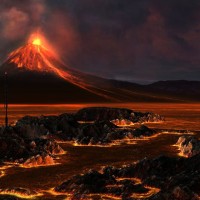Volcanoes

Volcanoes
~~A volcano can be said to be an opening or eruption in the surface of the Earth which allows hot lava, volcanic ash and gases to escape from the magma/rock chamber beneath the surface.
Volcanoes are commonly found where tectonic plates are either diverging or converging even though volcanoes are not usually created where two tectonic plates slide past one another. The Mid Atlantic ridge is an example of volcanoes caused by divergent tectonic plates pulling apart while the Pacific Ring of Fire has the examples of volcanoes caused by convergent tectonic plates coming together.
Volcanoes will also form where there is stretching and thinning of the Earth’s crust in the interiors of plates. This is found in the East African Rift, the Wells Gray-Clearwater volcanic field, and the Rio Grande Rift in North America.
How Volcanoes are Formed
Researchers have discovered why the very small and giant volcanoes are formed, have different magnitude and frequency while erupting. These experts from the universities of Bristol, Savoie, and Geneva carried out over 1.2 million simulations to establish the conditions in which the various sizes of volcanic eruptions occur.
Since the Earth interior is very hot, the left over heat from its formation continue to escape towards the surface combined with the heat released by decaying radioactive elements which give energy for a volcanic activity. The rock in the Earth’s interior gets warm as the heat rises which cause the rock to rise slowly toward the surface. While the heat causes the molten rock or magma to rise to the surface, the gas that escapes provides the driving force for volcanic eruptions. Steam is known as the common volcanic gas and they are formed when water within the Earth or rainwater soaked in the Earth is absorbed by the rock/magma and then heated.
Small and frequent eruptions are usually caused by the process of magna replenishment, stressing the walls around the rock/magna chamber to the breaking point. However, new research has discovered that larger and less frequent eruptions are triggered by a different phenomenon called ‘magna buoyancy’. This is a process where molten rock or magna accumulates until its buoyancy creates another kind of stress that cracks open the top rock chamber and triggers an eruption.
The researchers are now able to estimate that the rock chamber is able to contain a maximum of 35,000 km3 of eruptible rock/magma and 10 % of these are released during a super eruption. When it decide to break the only option is to leave evrything behinde and run.

